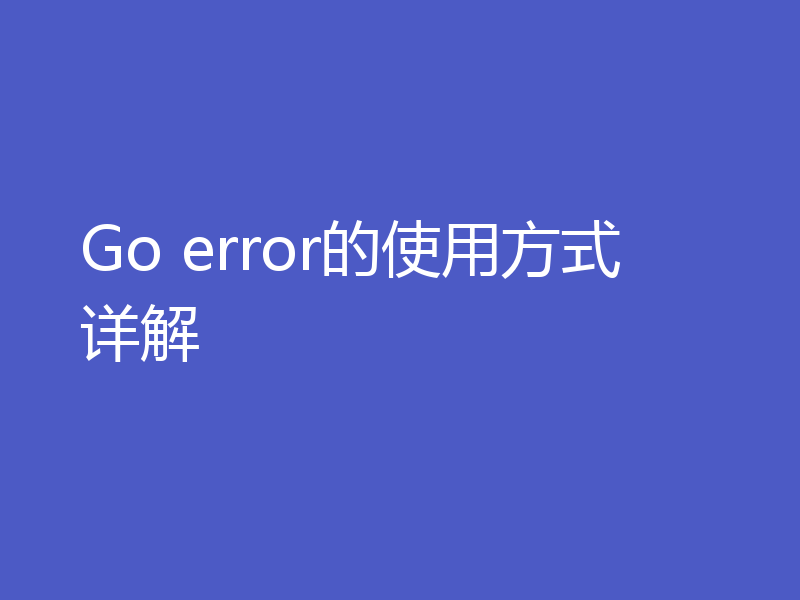golang中按照结构体的某个字段排序实例代码
来源:脚本之家
2022-12-24 21:55:22
0浏览
收藏
本篇文章主要是结合我之前面试的各种经历和实战开发中遇到的问题解决经验整理的,希望这篇《golang中按照结构体的某个字段排序实例代码》对你有很大帮助!欢迎收藏,分享给更多的需要的朋友学习~
概述
golang的sort包默认支持int, float64, string的从小大到排序:
int -> Ints(x []int)
float64 -> Float64s(x []float64)
string -> Strings(x []string)
同时它还提供了自定义的排序接口Interface,此接口保护三个方法。
type Interface interface {
// Len is the number of elements in the collection.
Len() int
// Less reports whether the element with
// index i should sort before the element with index j.
Less(i, j int) bool
// Swap swaps the elements with indexes i and j.
Swap(i, j int)
}
golang默认提供了三个类型,他们都实现了Interface:
Float64Slice
IntSlice
StringSlice
从大到小排序
方法1:先使用提供的从大到小排序,再翻转
arr := []float64{0.1, 0.5, 0.8, 0.4, 0.2}
sort.Sort(sort.Reverse(sort.Float64Slice(arr)))
fmt.Println(arr) // [0.8 0.5 0.4 0.2 0.1]
方法二:自定义类型实现
type Float64SliceDecrement []float64
func (s Float64SliceDecrement) Len() int { return len(s) }
func (s Float64SliceDecrement) Swap(i, j int) { s[i], s[j] = s[j], s[i] }
func (s Float64SliceDecrement) Less(i, j int) bool { return s[i] > s[j] }
func main() {
arr := []float64{0.1, 0.5, 0.8, 0.4, 0.2}
sort.Sort(Float64SliceDecrement(arr))
fmt.Println(arr) // [0.8 0.5 0.4 0.2 0.1]
}
按照结构体的某个字段排序
按年纪从大到小排序
type Persons struct {
Age int
Height int
}
type PersonsSliceDecrement []Persons
func (s PersonsSliceDecrement) Len() int { return len(s) }
func (s PersonsSliceDecrement) Swap(i, j int) { s[i], s[j] = s[j], s[i] }
func (s PersonsSliceDecrement) Less(i, j int) bool { return s[i].Age > s[j].Age }
func main() {
arr1 := []Persons{
Persons{10, 12},
Persons{20, 12},
Persons{9, 12},
Persons{10, 12},
Persons{11, 12},
}
sort.Sort(PersonsSliceDecrement(arr1))
fmt.Println(arr1)
}
打印
[{20 12} {11 12} {10 12} {10 12} {9 12}]
按年纪从大到小,如果年纪相等的,按身高从小到到
type Persons struct {
Age int
Height int
}
type PersonsSliceDecrement []Persons
func (s PersonsSliceDecrement) Len() int { return len(s) }
func (s PersonsSliceDecrement) Swap(i, j int) { s[i], s[j] = s[j], s[i] }
func (s PersonsSliceDecrement) Less(i, j int) bool {
if s[i].Age > s[j].Age {
return true
}
if s[i].Age == s[j].Age && s[i].Height
<p>打印</p>
<blockquote><p>[{20 12} {10 11} {10 100} {10 110} {10 120}]</p></blockquote>
<h2>使用 sort.Stable 进行稳定排序</h2>
<p>sort.Sort 并不保证排序的稳定性。如果有需要, 可以使用 sort.Stable ,用法就是将sort.Sort 替换为 sort.Stable</p>
<p>附:go根据结构体中任意字段进行排序</p>
<h2>附:根据结构体中任意字段进行排序</h2>
<p>Sort()</p>
<p>Reverse()</p>
<p>Less(i,j int) bool</p>
<p>Len() int</p>
<p>Swap(i,j int)</p>
<pre class="brush:go;">package main
import (
"fmt"
"sort"
)
type Student struct {
Number string
Name string
Age int
IsWalker bool
Weight float32
}
type ByNumber []*Student
func (this ByNumber)Len() int {
return len(this)
}
func (this ByNumber)Less(i,j int) bool {
return this[i].Number<this func bynumber int this string const format="| %v |\t%v |\t%v |\t %v |\t %v |\t%v |\n" fmt.println for k fmt.printf return main1 sts:="[]*Student{" b:="ByNumber(sts)" sort.sort type customsort struct s less bool len this.s this.less main c:="&customSort{" s: sts less: j if i.number j.number>j.Number
}
if i.Name!=j.Name{
return i.Name<j.name return false package sort a type typically collection that satisfies sort.interface can be sorted by the routines in this package. methods require elements of enumerated an integer index. interface len is number collection. int less reports whether element with index i should before j. j bool swap swaps indexes and sort.sort fmt.println><h2>总结</h2>
<p>今天关于《golang中按照结构体的某个字段排序实例代码》的内容介绍就到此结束,如果有什么疑问或者建议,可以在golang学习网公众号下多多回复交流;文中若有不正之处,也希望回复留言以告知!</p></j.name></this> 版本声明
本文转载于:脚本之家 如有侵犯,请联系study_golang@163.com删除
 Go error的使用方式详解
Go error的使用方式详解
- 上一篇
- Go error的使用方式详解

- 下一篇
- Golang异常处理之defer,panic,recover的使用详解
查看更多
最新文章
-

- Golang · Go教程 | 22分钟前 |
- Golang迭代器与懒加载结合应用
- 110浏览 收藏
-

- Golang · Go教程 | 34分钟前 | 性能优化 并发安全 Golangslicemap 预设容量 指针拷贝
- Golangslicemap优化技巧分享
- 412浏览 收藏
-

- Golang · Go教程 | 34分钟前 |
- Golang代理模式与访问控制实现解析
- 423浏览 收藏
-

- Golang · Go教程 | 1小时前 |
- Golang事件管理模块实现教程
- 274浏览 收藏
-

- Golang · Go教程 | 1小时前 |
- Golang接口多态实现全解析
- 241浏览 收藏
-

- Golang · Go教程 | 2小时前 |
- GolangHTTP优化与中间件组合技巧
- 365浏览 收藏
-

- Golang · Go教程 | 2小时前 |
- Golang模块版本管理与升级技巧
- 247浏览 收藏
-

- Golang · Go教程 | 2小时前 |
- Golang实现WebSocket聊天教程
- 241浏览 收藏
-

- Golang · Go教程 | 2小时前 | 日志文件管理 lumberjack Golang日志滚动 log库 zap库
- Golang日志滚动实现全解析
- 467浏览 收藏
-

- Golang · Go教程 | 2小时前 |
- Nixflakes管理Golang依赖实现稳定构建
- 500浏览 收藏
查看更多
课程推荐
-

- 前端进阶之JavaScript设计模式
- 设计模式是开发人员在软件开发过程中面临一般问题时的解决方案,代表了最佳的实践。本课程的主打内容包括JS常见设计模式以及具体应用场景,打造一站式知识长龙服务,适合有JS基础的同学学习。
- 543次学习
-

- GO语言核心编程课程
- 本课程采用真实案例,全面具体可落地,从理论到实践,一步一步将GO核心编程技术、编程思想、底层实现融会贯通,使学习者贴近时代脉搏,做IT互联网时代的弄潮儿。
- 516次学习
-

- 简单聊聊mysql8与网络通信
- 如有问题加微信:Le-studyg;在课程中,我们将首先介绍MySQL8的新特性,包括性能优化、安全增强、新数据类型等,帮助学生快速熟悉MySQL8的最新功能。接着,我们将深入解析MySQL的网络通信机制,包括协议、连接管理、数据传输等,让
- 500次学习
-

- JavaScript正则表达式基础与实战
- 在任何一门编程语言中,正则表达式,都是一项重要的知识,它提供了高效的字符串匹配与捕获机制,可以极大的简化程序设计。
- 487次学习
-

- 从零制作响应式网站—Grid布局
- 本系列教程将展示从零制作一个假想的网络科技公司官网,分为导航,轮播,关于我们,成功案例,服务流程,团队介绍,数据部分,公司动态,底部信息等内容区块。网站整体采用CSSGrid布局,支持响应式,有流畅过渡和展现动画。
- 485次学习
查看更多
AI推荐
-

- ChatExcel酷表
- ChatExcel酷表是由北京大学团队打造的Excel聊天机器人,用自然语言操控表格,简化数据处理,告别繁琐操作,提升工作效率!适用于学生、上班族及政府人员。
- 3162次使用
-

- Any绘本
- 探索Any绘本(anypicturebook.com/zh),一款开源免费的AI绘本创作工具,基于Google Gemini与Flux AI模型,让您轻松创作个性化绘本。适用于家庭、教育、创作等多种场景,零门槛,高自由度,技术透明,本地可控。
- 3375次使用
-

- 可赞AI
- 可赞AI,AI驱动的办公可视化智能工具,助您轻松实现文本与可视化元素高效转化。无论是智能文档生成、多格式文本解析,还是一键生成专业图表、脑图、知识卡片,可赞AI都能让信息处理更清晰高效。覆盖数据汇报、会议纪要、内容营销等全场景,大幅提升办公效率,降低专业门槛,是您提升工作效率的得力助手。
- 3403次使用
-

- 星月写作
- 星月写作是国内首款聚焦中文网络小说创作的AI辅助工具,解决网文作者从构思到变现的全流程痛点。AI扫榜、专属模板、全链路适配,助力新人快速上手,资深作者效率倍增。
- 4506次使用
-

- MagicLight
- MagicLight.ai是全球首款叙事驱动型AI动画视频创作平台,专注于解决从故事想法到完整动画的全流程痛点。它通过自研AI模型,保障角色、风格、场景高度一致性,让零动画经验者也能高效产出专业级叙事内容。广泛适用于独立创作者、动画工作室、教育机构及企业营销,助您轻松实现创意落地与商业化。
- 3784次使用
查看更多
相关文章
-
- mysql timestamp字段规范使用详情
- 2023-01-02 206浏览
-
- Go语言实现常用排序算法的示例代码
- 2022-12-31 178浏览
-
- Golang中Map按照Value大小排序的方法实例
- 2023-02-18 493浏览
-
- 详解go语言中sort如何排序
- 2023-01-07 189浏览
-
- golang编程开发使用sort排序示例详解
- 2023-02-25 459浏览





